By Anupreeta Das
New Delhi: The video, taken this month, shows a Bangladeshi protester wearing a black T-shirt and standing on one side of an empty street. His arms are outstretched, and he is holding a stick in one hand.
Across the street stand several police officers, wearing bulletproof vests and helmets and pointing their guns at him. He does not move, daring the officers to shoot.
They begin to fire.
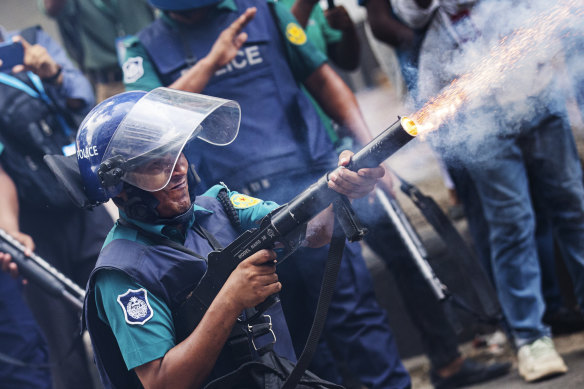
Police fire tear gas shells to disperse students in Dhaka, Bangladesh.Credit: AP
As Bangladesh was going through one of its worst bouts of violence since it gained independence in 1971, the video – verified by the news agency Storyful and carried by multiple television channels in the country – came to symbolise the helplessness and defiance of student protesters demanding the reform of a system of preferential treatment for coveted government jobs.
The government of Prime Minister Sheikh Hasina responded to the escalating protests by deploying ever greater force. Officials shut down the internet. Paramilitary troops were called in. A curfew was declared. Protesters were beaten, and more than 100 were killed. Late Friday, the government declared a nationwide curfew and brought the army in to restore order. On Saturday alone, the police reported that 12 people had died.
On Sunday, the Supreme Court of Bangladesh stepped in with a ruling that was a significant concession to the protesters – and one that could open up job opportunities for thousands of students.
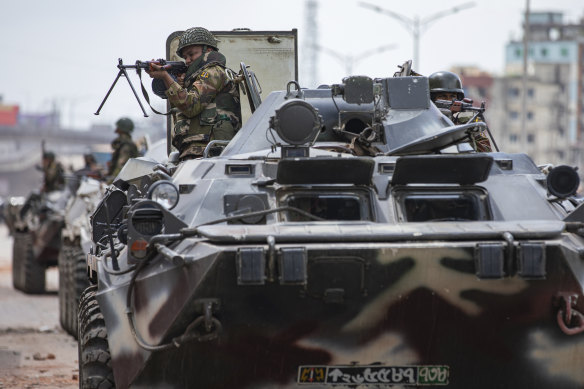
Bangladeshi military forces on armored vehicles patrol on the streets of Dhaka.Credit: AP
The streets of Dhaka, the Bangladeshi capital, were mostly empty after the verdict came down. A few protests were still going on, and helicopters were circling overhead as military patrols drove around the city. Some students said that they would continue to protest until the bill supporting the ruling was formally passed.
The protests erupted out of students’ anger at a quota system for public-sector jobs that benefited certain groups, including the families of war veterans. Collectively, the quotas added up to 56 per cent of all government jobs.
Under the Supreme Court’s orders, Bangladesh will now reserve only 7 per cent of those posts, a move that will open up many more civil service jobs to university students, who had called for a merit-based system.
The children and grandchildren of those who fought for the country’s independence from Pakistan in 1971 will have a quota of 5 per cent, down from 30 per cent. The ruling abolishes quotas for women and for those from certain districts. It also cuts the quota of jobs for ethnic minorities to 1 per cent, from 5 per cent, but leaves in place the 1 per cent of jobs that are reserved for people with disabilities.
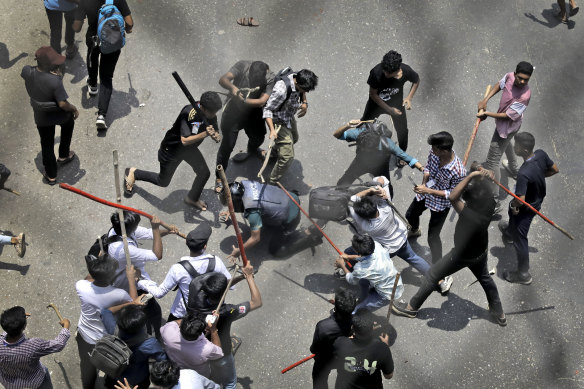
Students attack a policeman in Dhaka.Credit: AP
Analysts say the weekslong revolt reflected a broader resentment over the uneven distribution of wealth and opportunity in an economy that has begun to wobble after years of rapid growth.
The protests expressed the “frustration many people feel about how economic growth has been uneven, and there is huge inequality and corruption,” said Pierre Prakash, director of the Asia Program at the International Crisis Group. “The quota protest is just the manifestation of a widespread malaise that’s not just about quotas but also economic and political.”
In recent decades, Bangladesh’s economy has lifted millions out of poverty on the back of a robust garment-export industry. But the coronavirus pandemic hit hard, with consumers around the world cutting back on clothing purchases and remittances from the diaspora falling. At the same time, consumers endured an inflationary burst, with food and fuel costs rising sharply.
Inflation remains high at 10 per cent, and the pace of job creation has slowed. As of 2022, the youth unemployment rate, at 16.1 per cent, was about three times as high as the overall rate.
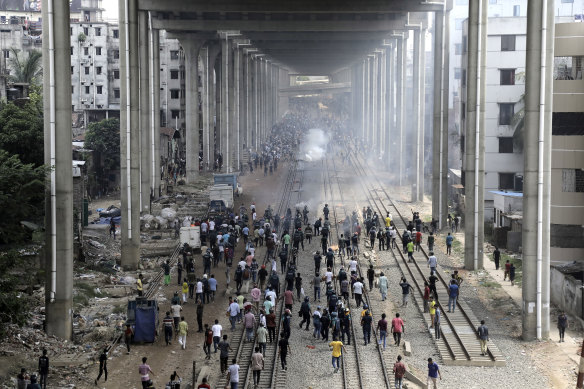
Students clash with police in Dhaka.Credit: AP
Public-sector jobs are desirable because they are stable and prestigious, and they come with generous benefits. But they are tough to obtain. Every year, roughly 4000 government positions open up, and more than 300,000 students compete for them.
Sheikh Mujibur Rahman, the country’s founding leader and Hasina’s father, created the quota system in 1972 to ensure that the thousands of men and women who fought in the war of independence from Pakistan would be taken care of.
The quota was extended in 1997 and in 2010 to include the children and then grandchildren of war veterans, leading to the perpetuation of a favoured class that many deemed unfair.
Over time, guaranteed government jobs created a “political class” and a hierarchy, as well as a class of wealthy people, said Saad Hammadi, a policy and advocacy manager at the Balsillie School of International Affairs in Ontario, Canada. That, along with the rising cost of living and clampdowns on free expression, brought Bangladeshis to this moment, Hammadi added.
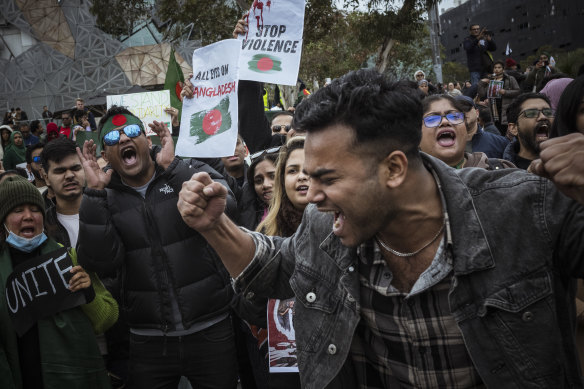
Members of Melbourne’s Bangladeshi community rally in Federation Square on Sunday.Credit: Chris Hopkins
“It was a volcanic eruption of all the frustrations people had been living with,” he said.
Other factors fuelled the anger. Last year, Bangladesh was ranked No. 149 out of 180 countries on an annual corruption index released by Transparency International, a global nonprofit.
Students and analysts said it was not unusual for someone to bribe an official for a government post or for the questions to an exam. Local papers recently reported on a long-running scheme to leak exam question papers, including those for the Bangladesh Civil Service exam, which is the qualifying test for a government job.
Anti-quota protests have erupted many times in the past two decades. The most recent demonstrations had their roots in a student movement that started in 2018 and that led Hasina to abolish the system. But after a lawsuit by the descendants of some freedom fighters, a court in June reinstated the quotas.
Initially peaceful, the demonstrations intensified after Hasina called the protesters “razakars” – a derogatory term for those who supported Pakistan during Bangladesh’s independence war.
“We demanded rights, but we got called ‘razakar’,” students chanted for days on the streets of Dhaka. As their cries faded amid the government’s crackdown, some Bangladeshi emigrants took up the cause. Protesters gathered in Sydney and Melbourne on the weekend.
This article originally appeared in The New York Times.
Get a note directly from our foreign correspondents on what’s making headlines around the world. Sign up for the weekly What in the World newsletter here.